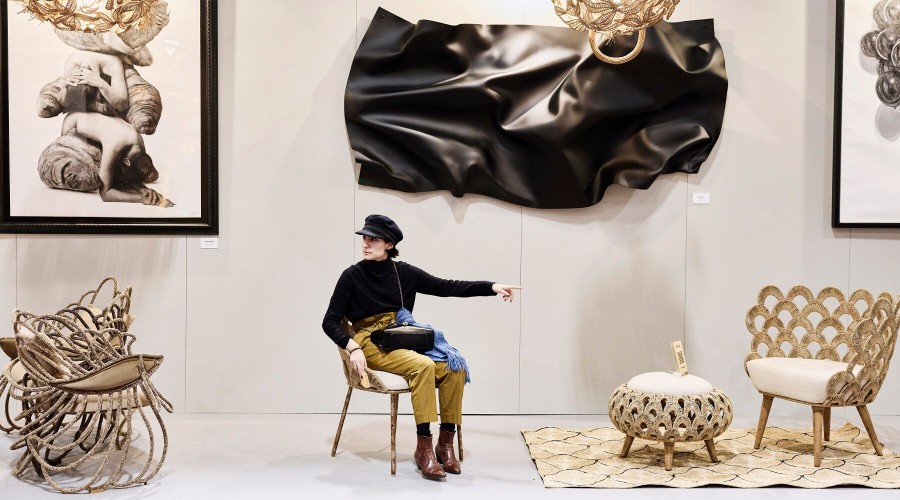PLAUTILLA BRICCI: Η πρώτη "αρχιτεκτόνισσα" του 17ου αι. που έμεινε στην αφάνεια.
DS.WRITER:
Sophia Throuvala
Κεντρική Εικόνα: Galleria Corsini, Una rivoluzione silenziosa, The “wall of talented women” at Galleria Corsini. Photo: Alberto Novelli | Πηγή εικόνας: https://artherstory.net/plautilla-bricci-artist-architettrice/
“Μια σιωπηλή επανάσταση: Plautilla Bricci ζωγράφος και αρχιτεκτόνισσα”, είναι ο τίτλος της πρώτης και σημαντικότατης έκθεσης (5/11-19/4) της ομώνυμης καλλιτέχνιδας στην οποία παρευρέθηκα. Τα έργα της Πλαουτίλα Μπρίτσι συγκεντρώθηκαν, συντηρήθηκαν και εκτέθηκαν για πρώτη φορά συλλογικά σε έναν από τους εμβληματικότερους χώρους της Ρώμης, στην Galleria Corsini, σε επιμέλεια του Yuri Primarosa. Ο σύγχρονος τρόπος έκθεσης στον χώρο της μόνιμης συλλογής των Corsini, με τη χρήση του έντονου, πλαστικού μπλε και κίτρινου χρώματος στις επιγραφές και στα κάδρα, αναπαριστούσε πραγματικά τη νέα προσθήκη στη λίστα με τα ονόματα καλλιτεχνών του Ρωμαϊκού Μπαρόκ. Ποια είναι όμως η Πλαουτίλα, γιατί δεν τη γνωρίζουμε; Πόσο σημαντική είναι ώστε να εκτεθούν τα έργα της σε μια από τις διασημότερες συλλογές της Ρώμης, και γιατί τώρα;
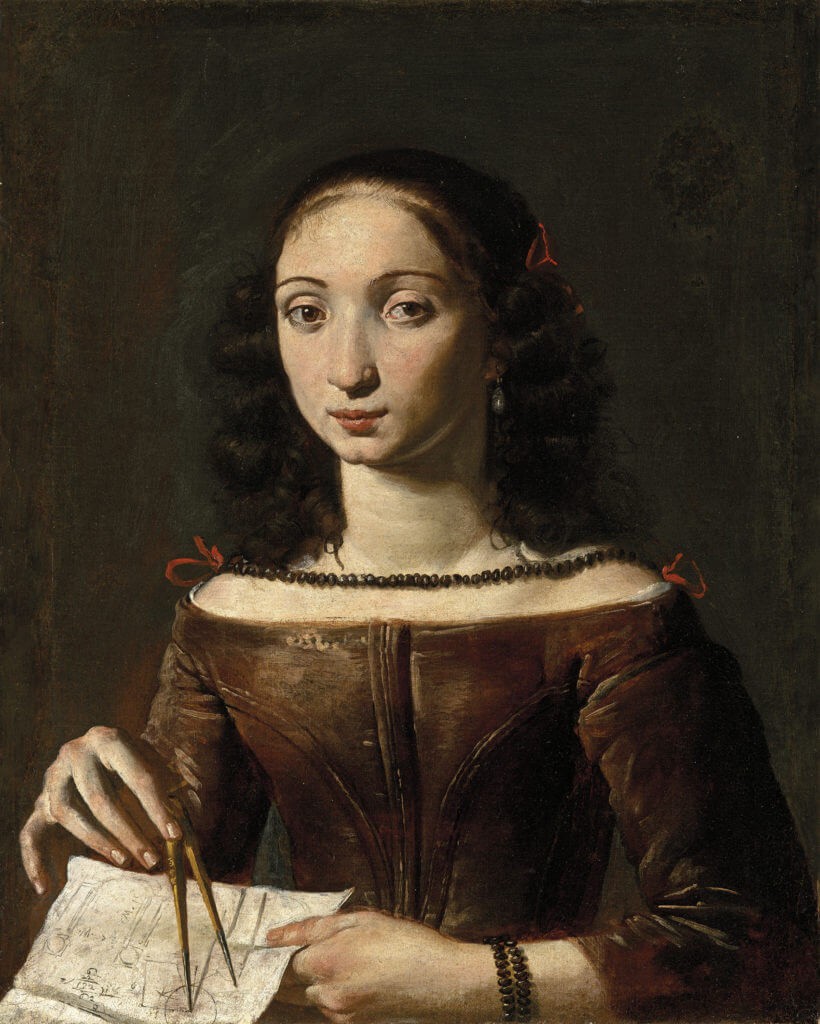
Αφίσα της έκθεσης Una rivoluzione silenziosa στη Galleria Corsini, Artist active in Rome, mid-17th century, Portrait of an architectures (ίσως πορτρέτο της Plautilla Bricci?), oil on canvas, 66.1 x 52.7 cm. Private collection, Los Angeles | Πηγή εικόνας: https://artsupp.com/en/artisti/plautilla-bricci/san-luigi-ix-di-francia-tra-la-storia-e-la-fede
Η Πλαουτίλα δεν είναι κάποια καλλιτέχνιδα σύγχρονη, ούτε κάποια νέα Αρτεμισία που ανακαλύφθηκε χθες. Είναι ωστόσο η πρώτη φορά που το σύνολο της δουλειάς της απασχολεί ειδικούς και μη, και εκτίθεται στο ευρύ κοινό συστήνοντάς τη με όνομα και ιδιότητα.
Η Ρωμαία καλλιτέχνιδα του 17ου αιώνα είναι η πρώτη και η μόνη γυναίκα που αυτοπροσδιορίζεται και υπογράφει ως αρχιτεκτόνισσα, δημιουργώντας έναν όρο ο οποίος έχει προκαλέσει το ενδιαφέρον στους μελετητές της ιστορίας της τέχνης και άλλων σχετικών κλάδων. Η “ανάγκη” για μια έκθεση σαν αυτή δεν προέκυψε, όπως αναφέρθηκε παραπάνω, από την ανακάλυψη μιας “καινούριας” ζωγράφου αντάξιας αναφοράς και προσθήκης στο καλλιτεχνικό πάνθεον του seicento, αντιθέτως η αφορμή ήταν ένα ιστορικό μυθιστόρημα. Το βιβλίο τής Μελάνια Ματζούκο (Melania Mazzucco), με τίτλο “L’architettrice’, μετράει ελάχιστο χρόνο στην αγορά και αποτελεί ένα από τα μεγαλύτερα best seller ιταλικής λογοτεχνίας. Το θέμα του είναι, όπως προδίδει ο τίτλος, η ιστορία της πρώτης “μοντέρνας” αρχιτεκτόνισσας στην πόλη των παπών και του baroque μεγαλείου. Είναι ενδιαφέρον πως η μαζική ανταπόκριση σε μια μυθοπλασία έφερε στο φως κάτι το οποίο δεν ήταν τελικά και τόσο κρυμμένο, ωστόσο παρέμενε άγνωστο στο ευρύ κοινό. Το όνομα και μερικά έργα της Πλαουτίλα Μπρίτσι.
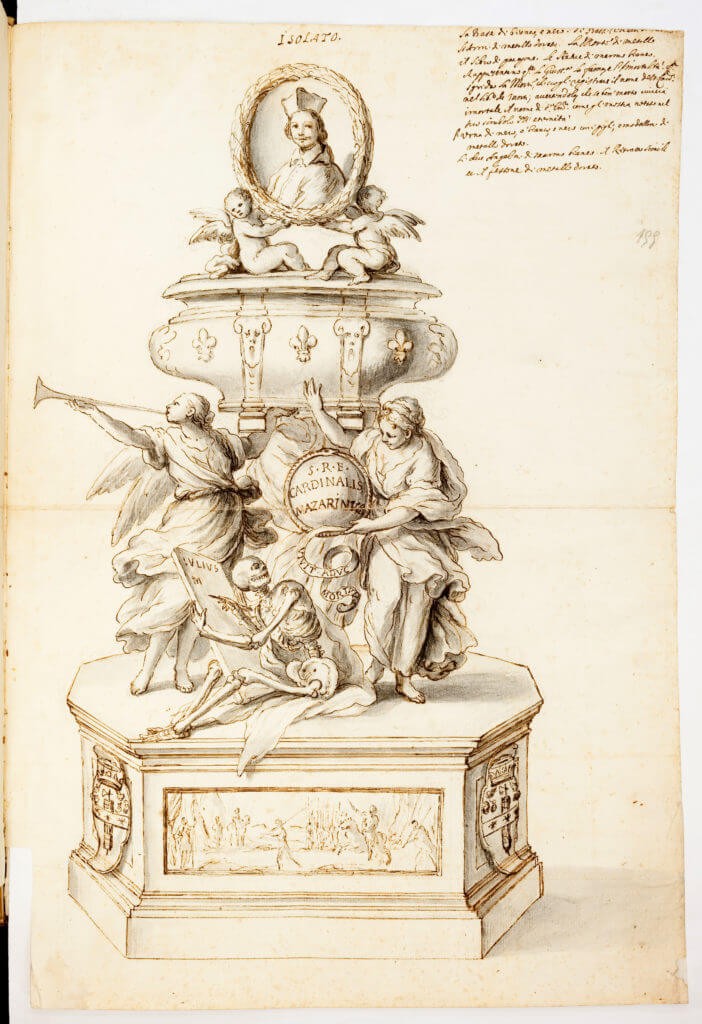
Plautilla Bricci, Drawing for the tomb of Cardinal Giulio Mazzarino, post 1661. National Library, Turin; image courtesy of Consuelo Lollobrigida | Πηγή εικόνας: https://artherstory.net/plautilla-bricci-1616-1705/
Η Πλαουτίλα, σχεδόν αυτοδίδακτη καλλιτέχνιδα της εποχής της, χωρίς οικογένεια παπική ή ευκατάστατη, κατάφερε με τη φιλοδοξία της να αφήσει μια κληρονομιά που ακόμα μπορεί κανείς να εντοπίσει σε μερικά από τα τουριστικότερα σημεία της Ρώμης. Παρόλα αυτά παραμένει “άγνωστη”. Ο πατέρας της ήταν ζωγράφος, συνθέτης, μουσικός και δραματουργός με γνωριμίες στην εκκλησία των Καρμελιτών και στους καλλιτεχνικούς κύκλους της εποχής του. Λειτούργησε ως διαμεσολαβητής, ώστε η Πλαουτίλα να έρθει σε επαφή με την τέχνη παρά το φύλο και την τάξη της, στοιχεία που, σε συνδυασμό, απαγόρευαν δογματικά την πρόσβαση στη μόρφωση και τα ευγενή επαγγέλματα. Ανύπαντρη και δημιουργική, αφιέρωσε όλη της τη ζωή στην τέχνη, ζώντας πάντα μαζί με την οικογένειά της, αφού μια γυναίκα δεν θα μπορούσε να μένει μόνη, όσο αυτόνομη κι αν ήταν. Δημιουργώντας μια στενή σχέση με τον καλλιτέχνη (αποκλειστικό του Giulio Mazzarino και έπειτα του Jean-Baptiste Colbert, δηλαδή της γαλλικής αριστοκρατίας) Ελπίντιο Μπενεντέτι (Elpidio Benedetti), κατάφερε να έρθει σε επαφή με την τέχνη, τους καλλιτέχνες της εποχής της στη Ρώμη αλλά και με τη γαλλική κουλτούρα, στοιχεία που την επηρέασαν σημαντικά στο έργο της.
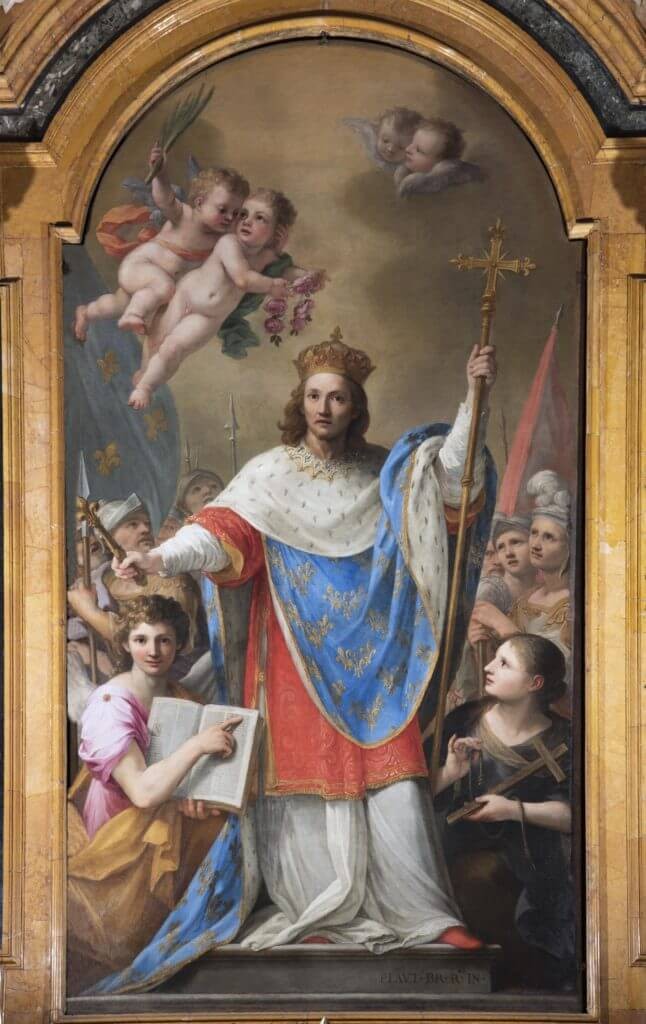
Το σημαντικότερο έργο της Plautilla Bricci, Saint Louis IX of France between History and Faith, 1676–1680, oil on canvas, 321 x 164 cm. Rome, San Luigi dei Francesi | Πηγή εικόνας: https://artsupp.com/en/artisti/plautilla-bricci/san-luigi-ix-di-francia-tra-la-storia-e-la-fede
Η Πλαουτίλα αρχίζει να υπογράφει όλα τα ζωγραφικά της έργα ως “Plautila Bricci, invenit et pinxit”, δηλαδή “σκέφτηκε και εποίησε”, διαφοροποιώντας εμφανώς τον εαυτό της από καλλιτέχνες των διάφορων σχολών οι οποίοι αναπαρήγαγαν εκδοχές από θέματα σπουδαίων ζωγράφων όπως ο Καραβάτζο. Η ανάγκη της να ονομάσει τη δουλειά της ως προσωπική δεν είναι κάτι που συναντάμε συχνά, ειδικά σε “άσημους” καλλιτέχνες, ενώ επίσης η μεταποίηση της λέξης αρχιτέκτονας σε αρχιτεκτόνισσα, δηλώνοντας εμφανώς το φύλο της, αποτελεί μοναδική προσθήκη στην τεχνοκριτική ορολογία. Ακόμα και αν η Πλαουτίλα δεν υπήρξε ποτέ μια καλλιτέχνιδα με μεγάλη παραγωγή, βάσει αυτών που γνωρίζουμε ως σήμερα, υπήρξε μια πολύ δραστήρια και γνωστή παρουσία, η οποία γνώριζε και εμπνεόταν από καλλιτέχνες όπως ο σπουδαίος Gian Lorenzo Bernini, ο Pietro da Cortona, ο Andrea Sacchi, ο Giovan Francesco Grimaldi και ο Giovan Francesco Romanelli. Ένας από τους γνωστότερους βιογράφους της εποχής, ο Filippo Baldinucci, γράφει τη βιογραφία της και δοξάζει τις αρχιτεκτονικές ικανότητές της και την ευφυΐα της.
.jpg)
Galleria Corsini, Una rivoluzione silenziosa | Πηγή εικόνας: http://fotoweb.cultura.gov.it/fotoweb/albums/YYPLK2dMz2iTlLRg/
Η Πλαουτίλα, λοιπόν, αποτελεί τη μόνη γυναίκα που εξασκούσε το επάγγελμα του αρχιτέκτονα, και μάλιστα τα σχέδιά της δεν έμειναν μόνο στο χαρτί αλλά υλοποιήθηκαν. Συγκεκριμένα, η εμβληματική Villa Benedetta στην Porta San Pancrazio, επονομαζόμενη ως “il Vascello”, αποτελούσε έναν χάρτη της υψηλής τέχνης της εποχής, με τη συνεργασία μερικών από τους σημαντικότερους καλλιτέχνες της γενιάς τους, όπως τον Μπερνίνι, τον Κορτόνα και τον Γκριμάλντι. Το κτήριο καταστράφηκε ολοσχερώς το 1849 από τους Γάλλους. Πέραν της Βίλας, η Πλαουτίλα τολμά και προτείνει δημόσια έργα όπως την staircase στην Trinità dei Monti στην Piazza di Spagna, η οποία δεν υλοποιείται, ωστόσο με τη βοήθεια του Ελπίντιο αποκτά μια πρωτοφανή εκτίμηση της δουλειάς της και ορατότητα σε μια ανδροκρατούμενη κοινωνία καλλιτεχνών και παραγγελιοδοτών.
.jpg)
Galleria Corsini, Una rivoluzione silenziosa | Πηγή εικόνας: http://fotoweb.cultura.gov.it/fotoweb/albums/YYPLK2dMz2iTlLRg/
Συλλαμβάνει και υλοποιεί μερικά από τα ομορφότερα αλτάρια και παρεκκλήσια στη Ρώμη, με σημαντικότερο αυτών το συμπλεγματικό έργο στην εκκλησία San Luigi dei Francesi, την έδρα της Γαλλικής εκκλησίας στη Ρώμη. Σχεδιάζει και δημιουργεί την μπαρόκ καπέλα σε όλα τα επίπεδα, από τα γλυπτά και τα ανάγλυφα μέχρι την αρχιτεκτονική σύνθεση, και φυσικά ζωγραφίζει το πολύ διάσημο αλτάρι. Πρόκειται για την απόλυτη πραγμάτωση της εικαστικής ευφυΐας genio από μια γυναίκα εντός ενός από τους σπουδαιότερους θρησκευτικούς και πολιτικούς χώρους της εποχής της, πλάι στο διάσημο τρίπτυχο του Καραβάτζο για τη ζωή του Ματθαίου. Επιπλέον, από το 1675 μέχρι το 1686 δημιουργεί έργα στη Βασιλική του Αγίου Ιωάννη Λατεράνο, τοιχογραφίες στον Άγιο Δομίνικο κ.α. Με την ορολογία της εποχής πρόκειται για μια gentiluomo ή/και uomo universalis, δηλαδή για έναν απόλυτα ικανό και ταλαντούχο άνθρωπο.
Με την επανεμφάνιση της Πλαουτίλα, αλλά και με τον τρόπο που αυτή προσλαμβάνεται και αποδίδεται ως παρουσία μέσα από την έκθεση στην Galleria Corsini, γεννιούνται κάποια ερωτήματα στα οποία δεν είναι ακόμα εύκολο να απαντήσουμε. Η αρχειακή έρευνα που πυροδοτήθηκε, αρχικά με αφορμή το μυθιστόρημα της Ματζούκο και έπειτα με τις παράλληλες δράσεις της έκθεσης, συντελούν στην προσθήκη της καλλιτέχνιδας στην ιστορία της τέχνης, όπως υπέδειξε πρώτη η Linda Nochlin τη δεκαετία του ‘70 στο έργο της “Why have there been no great women artists?”. Η Nochlin έκανε λόγο για το πώς η παρουσία των γυναικών καλλιτεχνών παρακάμπτεται κατά την καταγραφή της ιστορίας, κατά την κοστολόγηση και εκτίμηση του ταλέντου τους, αλλά και για το ότι δεν συμπεριλαμβάνονται σε ιστορικές εκθέσεις.
.jpg)
Galleria Corsini, Una rivoluzione silenziosa | Πηγή εικόνας: http://fotoweb.cultura.gov.it/fotoweb/albums/YYPLK2dMz2iTlLRg/
Με πολύ μεγάλη προσπάθεια, πρώτα από την ίδια τη Nochlin και έπειτα από άλλες φεμινίστριες ιστορικούς και θεωρητικούς της τέχνης που ακολούθησαν τη μέθοδό της ή δημιούργησαν νέες, ο κατάλογος των γυναικείων ονομάτων εμπλουτίστηκε αλλά παραμένει ελλιπής και σύντομος. Είναι σημαντικό να τονιστεί ωστόσο πως, δεδομένης της μη πρόσβασης των γυναικών στην ακαδημαϊκή μόρφωση και στον ευρύτερο δημιουργικό και επαγγελματικό χώρο, ειδικά τον 16-17ο αιώνα στον οποίο αναφερόμαστε, είναι λογικό να μην υπάρχουν τόσες γυναικείες μορφές όσο ανδρικές, όπως επίσης είναι ιστορικά επόμενο οι επαγγελματικοί όροι όπως αρχιτέκτονας να έχουν μόνο αρσενικό γένος, λόγω της αποκλειστικής απασχόλησης ανδρών στον τομέα αυτόν. Όμως, το πρόβλημα της ιστοριογραφίας μιας καλλιτέχνιδας που είχε τόσο έντονη παρουσία στην εποχή της αλλά και στο καλά διατηρημένο παρελθόν -που είναι υπερ-επισκέψιμο στο παρόν- αποτελεί σύγχρονο πρόβλημα, όπως και η επανεξέταση των όρων που χρησιμοποιούμε για να μιλήσουμε για αυτές.
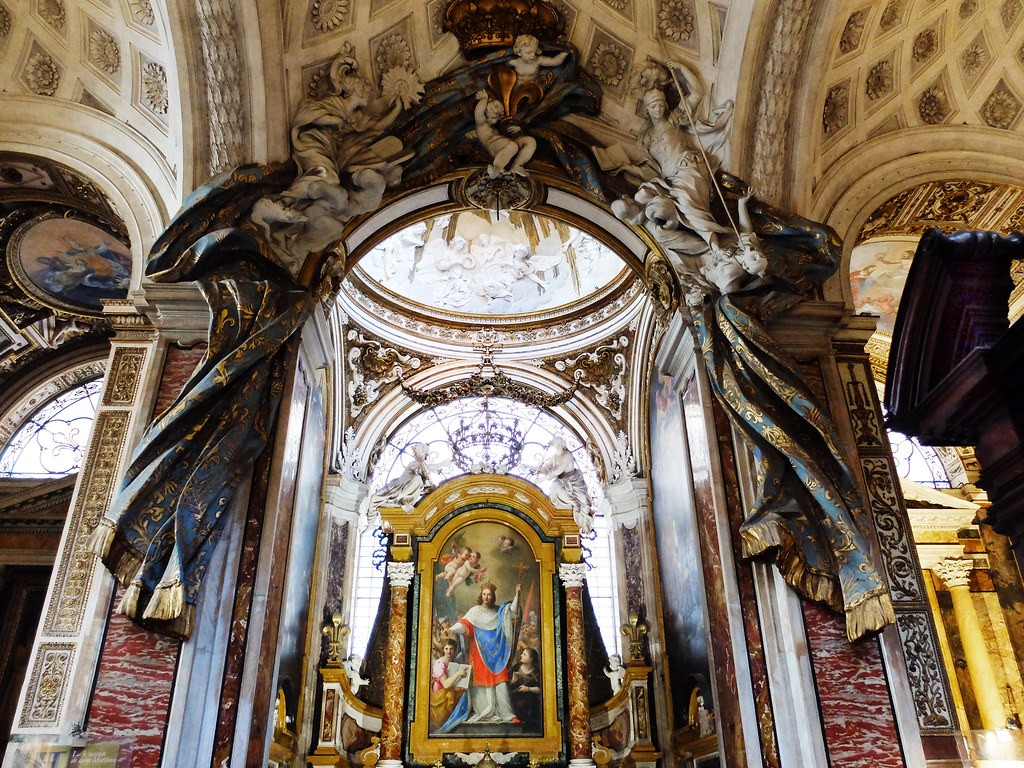
Plautilla Bricci, Saint Louis IX of France between History and Faith, 1676–1680, oil on canvas, 321 x 164 cm. Rome, San Luigi dei Francesi, chapel, altar and sculptures | Πηγή εικόνας: https://en.wikipedia.org/wiki/San_Luigi_dei_Francesi
Το ερώτημα εν προκειμένω, το οποίο δεν γνωρίζω αν η έκθεση ή το βιβλίο αγγίζουν, είναι το εξής: Πώς μια καλλιτέχνιδα, της οποίας τα έργα βρίσκονται εντός μελετημένων ιστορικά χώρων (όπως η εκκλησία του San Luigi dei Francesi ή ακόμα και το Βατικανό), η οποία μάλιστα δημιούργησε νέο επαγγελματικό τίτλο ώστε να αυτοπροσδιοριστεί και να διαφοροποιηθεί βάσει φύλου, παρέμεινε σχετικά άγνωστη και δεν ιστοριογραφήθηκε μέχρι σήμερα; Η απάντηση μπορεί να έρθει από τη Nochlin, η οποία σημείωνε πως η γενική εικόνα της καταγεγραμμένης ιστορίας της τέχνης είναι αυτή των ανδρών. Μπορούμε να αναλογιστούμε πολλά με αφορμή το γεγονός πως το αίτημα της Nochlin παραμένει επίκαιρο και σημαντικό.
Ίσως, λοιπόν, με αφορμή την αποσιώπηση και επανανακάλυψη της Πλαουτίλα Μπρίτσι, να ξεκινήσει ένας γόνιμος διάλογος για την τέχνη και την εργασία την περίοδο του μπαρόκ, για τη χρήση των όρων και πώς αυτοί διαμορφώθηκαν και χρησιμοποιούνται μέχρι σήμερα, και τέλος για το πολύ ενδιαφέρον ζήτημα της ορατότητας έργων, τα οποία, ενώ βρίσκονται σε κοινή θέα για αιώνες, επισκιάζονται από έναν υπερτουρισμό που ευνοεί άλλα έργα και καλλιτέχνες.
https://artherstory.net/plautilla-bricci-1616-1705/
https://artherstory.net/plautilla-bricci-artist-architettrice/
Una rivoluzione silenziosa. Plautilla Bricci pittrice e architettrice




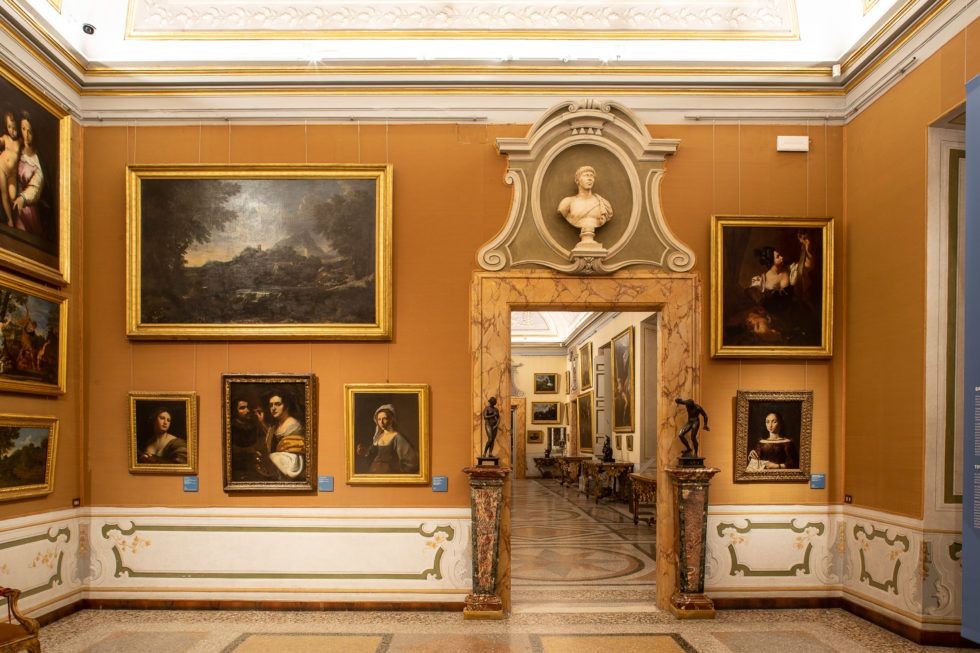

.jpg)
.jpg)
